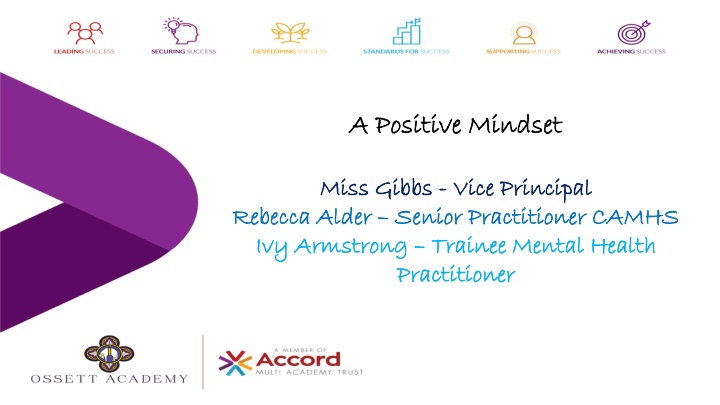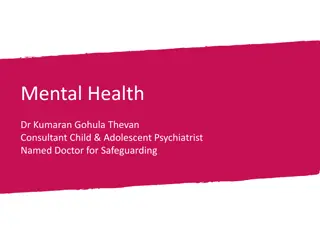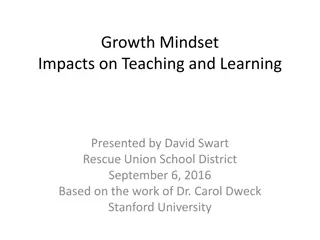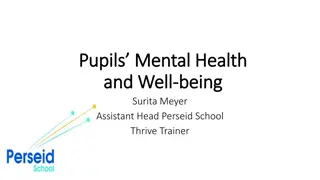Promoting Mental Health and Well-Being Through Positive Mindset Practices
Learn how to cultivate a positive mindset for improved mental health and well-being. Discover practical tips such as talking about your feelings, staying positive, focusing on the good, and keeping a healthy attitude. These practices aim to enhance resilience, coping mechanisms, and overall emotional health.
Download Presentation

Please find below an Image/Link to download the presentation.
The content on the website is provided AS IS for your information and personal use only. It may not be sold, licensed, or shared on other websites without obtaining consent from the author.If you encounter any issues during the download, it is possible that the publisher has removed the file from their server.
You are allowed to download the files provided on this website for personal or commercial use, subject to the condition that they are used lawfully. All files are the property of their respective owners.
The content on the website is provided AS IS for your information and personal use only. It may not be sold, licensed, or shared on other websites without obtaining consent from the author.
E N D
Presentation Transcript
A Positive Mindset A Positive Mindset Miss Miss Gibbs Gibbs - - Vice Principal Vice Principal Rebecca Alder Rebecca Alder Senior Practitioner CAMHS Senior Practitioner CAMHS Ivy Armstrong Ivy Armstrong Trainee Mental Health Trainee Mental Health Practitioner Practitioner
Talk about Talk about your your feelings feelings Do Do Something Something Creative Creative Do one Do one thing thing at a at a time time
Talk about Talk about your your feelings feelings Do Do Keep a Keep a positive positive attitude attitude Something Something Creative Creative Do one Do one thing thing at a at a time time Eat well Eat well and keep and keep fit fit
Talk about Talk about your your feelings feelings Do Do Keep a Keep a positive positive attitude attitude Something Something Creative Creative All All things things come come and go and go Focus Focus on you on you Do one Do one thing thing at a at a time time Practice Practice being being curious curious What if? What if? Eat well Eat well and keep and keep fit fit
Keep a Keep a positive positive attitude attitude
A A positive positive Mindset Mindset
Focus on the good Think rationally A A positive positive Mindset Mindset Visualise it going well Reframe your situation
A bad filter A bad filter. Do they overlook the good things about a situation and get wrapped up in the negatives? For example, you enjoy a fun dinner out with friends, but the restaurant gets your bill wrong at the end of the night. You leave feeling annoyed and frustrated, forgetting about the good time you had. Fix the Fix the negatives negatives
A bad filter A bad filter. Do they overlook the good things about a situation and get wrapped up in the negatives? For example, you enjoy a fun dinner out with friends, but the restaurant gets your bill wrong at the end of the night. You leave feeling annoyed and frustrated, forgetting about the good time you had. Taking the blame. Taking the blame. Do they tend to take on the blame for something bad or disappointing that happens? For example, a friend declines an invitation from you, so you assume it s because they don t want to spend time with you. Fix the Fix the negatives negatives
Predicting disaster. Predicting disaster. This means they have one setback and then expect the worst to happen. For example, your car won t start in the morning, so you think the rest of your day is destined to be doomed. Fix the Fix the negatives negatives
Predicting disaster. Predicting disaster. This means they have one setback and then expect the worst to happen. For example, your car won t start in the morning, so you think the rest of your day is destined to be doomed. Fix the Fix the negatives negatives Black Black- -and or bad, with no middle ground? In this mindset, if things aren t perfect, they re automatically bad. and- -white thinking. white thinking. Do they see things as either good
Experiencing lots of change in a short space of time, such as moving house or school Having responsibilities that are beyond their age and development, for example caring for other people in their family Being around someone who is very anxious, such as a parent Struggling at school, including feeling overwhelmed by work, exams or peer groups Experiencing family stress around things like housing, money and debt Going through distressing or traumatic experiences in which they do not feel safe.
Talking to your child about how theyre feeling can be hard. You might feel like you don t know where to start or when a good time to talk is. By taking 20 minutes to do an activity you both enjoy, you can create a relaxed space for getting the conversation started. All children and young people feel worried sometimes, and this is a normal part of growing up. Anxiety can become a problem when a young person feels stuck in it, or when it feels like an overwhelming, distressing or unmanageable experience. If your child is struggling with anxiety, there are things you can do to help them including providing emotional support, working on practical strategies together and finding the right professional help if they need it.























